Form Gene Clustering Method about Pan-Ethnic-Group Products Based on Emotional Semantic
2016-12-09CHENDengkaiDINGJingjingGAOMinzhuoMADanpingandLIUDonghui
CHEN Dengkai, DING Jingjing, GAO Minzhuo, MA Danping, and LIU Donghui
Form Gene Clustering Method about Pan-Ethnic-Group Products Based on Emotional Semantic
CHEN Dengkai*, DING Jingjing, GAO Minzhuo, MA Danping, and LIU Donghui
The use of pan-ethnic-group products form knowledge primarily depends on a designer’s subjective experience without user participation. The majority of studies primarily focus on the detection of the perceptual demands of consumers from the target product category. A pan-ethnic-group products form gene clustering method based on emotional semantic is constructed. Consumers’ perceptual images of the pan-ethnic-group products are obtained by means of product form gene extraction and coding and computer aided product form clustering technology. A case of form gene clustering about the typical pan-ethnic-group products is investigated which indicates that the method is feasible. This paper opens up a new direction for the future development of product form design which improves the agility of product design process in the era of Industry 4.0.
emotional semantic, pan-ethnic-group products, gene extract, gene coding, form gene clustering
1 Introduction
With the development of science and technology, we have achieved significant progress in the economy and society since the 21st century. Due to ever-increasing challenges and the arrival of Industry 4.0[1], the competition of manufacturing products is becoming more complicated, with minimal differences in manufacturing technologies, which produces the phenomenon of product homogeneity[2]. Therefore, product innovation at the design stage is becoming a hot spot of design research and application[3], and it is a key factor of enterprise innovation[4]. One of the connotations of Industry 4.0 is humanization, today’s market is a “buyers’ market”, in which user needs tend to be more diversified and personalised, and users’ perceptual demands of products are more and more important in the process of innovative design. Perceptual image is a highly condensed and deep emotional activity that is produced by a variety of sensory organs instead of a signal sensory organ[5]. The emotional needs or the so-called perceptual demands of the users, become one of the concerns in the design domain[6–8]. New technology products focus on the perceptual demands of users[9]. Numerous studies address the mining of users’ perceptual demands. YANG Jie, et al[10], put forward a mapping model of customer’s kansei cognition and product features based on fuzzy cognitive map, and the authors used ant colony clustering algorithm to determine the structure and adjacent matrix of fuzzy cognitive map to acquire customer’s kansei cognition. ZHAI Lianyin, et al[11], proposed a new decision support approach that was based on the principles of dominance-based rough set theory for the study of interactions between consumer affective needs and product features in product design. The proposed approach was able to handle imprecise consumer perceptions and discover latent patterns to guide affective design. PETIOT J F, et al[12], presented a general approach to assess product semantics in a sound way. It was based on usability tests, and several classical methods were involved in marketing and decision-making theory, such as multidimensional scaling, semantic differential method, factor analysis, pairwise comparison and analytical hierarchy process. ZHOU Meiyu, et al[13], analyzed the data from questionnaire by the cluster approach based on sorting. Then the quantitative relationship between the design elements and the kansei features of the similar consumers was obtained. JIAO Jianxin, et al[14], reused sales records and product specification of knowledge to enhance perceptual mapping process through the establishment of the perceptual mining system. HU Weifeng, et al[15], proposed the thought and method flow of automobile styling gene evolution driven by users’ expectation image based on genetic algorithm. LUO Shijian, et al[16], proposed an approach of consumer preference-driven sport utility vehicle(SUV) product family profile gene design for further exploring the diversified demands of innovation design for car designers and brand cognition for consumers. ZHANG Yanhe, et al[17], analyzed the formation mechanism of the user perception image(UPI) and proposed the UPI model of mental construction in order to obtain the relationships among the product whole perception image(PWPI), the product sub-perception image(PSPI) and the product elements (PE). SU Jianning, et al[18], presented a new evaluation method using the entropy theory aimed at the cognitive differences in product styling image. SHIEH Mengdar, et al[19], used a systemic approach to perform a visual design of a toothbrush by combining the kansei engineering and rough set theory for exploring the relationship between form and color during a product evaluation. LLINARES C, et al[20], proposed the use of Kano’s model to analyse the impact of different subjective attributes on consumers’ purchase decisions. These studies mainly focused on detecting the perceptual demands of consumers from the target product category, but lacked perceptual demand mining from kin products and foreign products.
Designers and manufacturers are now concerned about the perceived product image[21]. Perceptual image form design is human centered design, which can make consumers achieve more psychological pleasure and satisfaction by completely understanding the psychological needs of consumers and exploring consumer internal expectations of products and the value orientation[22]. Kansei engineering developes into products innovative technology for the consumers[23–24]. HAN Weirong, et al[25], studied the gene extraction of product forms and application based on constraint style, combined the product form with product style. In Ref. [26], the feature elements of product model are combinatorially optimized by the ant colony algorithm, which achieves a variety of product modeling schemes with a small amount of product samples. And the products meeting the emotional requirement of consumers are designed fast. Finally, a case study of electric kettle design shows that the method could optimize product design effectively. FU Yetao[27]identified the different preferences of consumers, and created the corresponding different product image based on user preferences. LUO Shijian, et al[28–29], proposed an approach of Vision-Behavior-Emotion(VBE) based product family design gene, put forward the VBE-based hierarchical model of product family design gene, andused perceptual matching to examine whether a product design gives consumers an accurate image and arouses their visual and affective perceptions according to the designers’ expectations. YANG Yanpu, et al[30], proposed a clustering method based on design structure matrix(DSM) and genetic algorithms(GA). By analyzing the characteristics of consumer’s perceptual needs, it constructed the DSM model for perceptual needs clustering by transforming the ranks of matrix elements. Based on encoding chromosome of the DSM model, it built the fitness function to find the optimal clustering scheme of consumer’s perceptual needs through genetic manipulation. XIONG Yan, et al[31], put forward a product form design method based on quantizing form feature lines, semantic differential, factor analysis and multiple linear regression methods were used synthetically to deal with product images data, then the relations between images and feature lines were determined. HSIAO Shihwen, et al[32], proposed a shape morphing and image prediction method for product design, in which a feature-based method was first used to construct 3D CAD models of a product, then new shapes were generated with a shape morphing method and the images of the morphed shapes were analyzed using modified gray theory with Fourier residual correction. SEVA R R, et al[33], explored how cellular phone attributes influence the affective experiences of users. It was hypothesized that product attributes triggered emotional responses and that different sets of product attributes triggered intense emotional responses in Singapore and Philippines, two countries with different cultures. PARK J, et al[34], proposed a fuzzy rule-based approach to build models relating product design variables to affective user satisfaction. Affective user satisfaction such as luxuriousness, balance, and attractiveness were modeled for office chair designs. LAI Hsinhsi, et al[35–36], put forward a user-oriented design method for the optimal combination on product design, and developed the concept of “feeling quality” to concretize the feeling effects evoked by a product. A robust design method was applied to enhance this quality by reducing the discrepancy between the actual consumer feeling and the target feeling, and by reducing the feeling ambiguity induced by the highly individualized characteristics of the consumers. Traditional perceptual engineering research focused on detecting the perceptual consumer demand from the target product category, the use of pan-ethnic-group product form knowledgeis primarily dependent on the designer’s subjective experience, lacks effective clustering method for product form elements. To address this problem, this paper constructs a pan-ethnic-group products[37]form gene clustering method.
2 Pan-Ethnic-Group Products Form Gene Clustering Method
2.1 Basic concept of pan-ethnic-group products
According to modern anthropology research, an ethnic group refers to a group with distinct cultural traits in a larger social system[38]. Regarding products, product groups are divided into several classes according to the characteristics of their properties, and the product with individual feature attribute matches to corresponding groups, then they will form product groups according to the matching degree. As the human family relatives have similar features, the products of one enterprise can also have the same “appearance”, which is the product style. We combined products in one ethnic group with products in another ethnic group, and referred to them as pan-ethnic-group products. “Pan” indicates a wide aspect, large scope and popularity.
2.2 What are product form genes?
A gene is a nucleic acid fragment that contains specific genetic function. By gene recombination and mutation, organisms continuously evolve and subsequently obtain a stronger ability to adapt to the external environment. A similar idea of evolution also exists in product form design. Product form genes are form units that are common and similar in a product group. They constantly interact with a design scenario or product environment, which causes the evolution of products to proper form[39]. The concept of form genes embodies the generality in the product family. The products with similar form characteristics will enable users to have similar perceptual images. A curve tree corresponds to the curve description, which is used to describe product form genes.
2.3 What are features of pan-ethnic-group products’ form genes?
The advantage of a pan-ethnic-group is that designers can not only utilise the existing design method from product family to form a series of products, but also gain inspirations from different ethnic groups to extract ideal design elements. Thus they will produce more innovative solutions that are consistent with the users’ preferences. As pan-ethnic-group products’ form genes are complicated, diverse and highly adaptable, they will be helpful in product form evolution.
2.4 Why the group form gene clustering is needed?
The use of pan-ethnic-group products form knowledge is primarily dependent on the designer’s subjective experience. The form gene clustering method overcomes this problem as it considers the users’ perceptual images about products and can provide inspirations for designers.
2.5 How to cluster pan-ethnic-group products form genes?
The form gene clustering method about pan-ethnic-group products based on emotional semantic is divided into three phases, as shown in Fig. 1.The first stageinvolves main product semantic acquisition and optimization from pan-ethnic-group products samples and the determination of typical word semantic membership. The second stageentails form gene extraction and coding of pan-ethnic-group products. The third stageinvolves form gene clustering about pan-ethnic-group products based on emotional semantic which yields innovation solutions about form elements among different ethnic group products.
3 Emotional Semantic Acquisition of Pan-Ethnic- Group Products
3.1 Collection and initial optimization of semantic words set
After collecting sample pictures of extensive pan- ethnic-group products, we firstly classified these pictures primarily, then determined semantic description words of the samples. By focusing on the form of objects, emotional feeling of the subjects would be revealed, such as preference, excitement, insipidity and disgust[40].

Fig. 1. Form gene clustering method about pan-ethnic-group products based on emotional semantic
We collected various types of words to describe the product form style via websites, manufacturer evaluations, advertisements, literature, interviews, dictionaries, televisions, magazines and other sources. Then, we selected product description semantics and record the selection frequency according to the requirements of the semantic differential method[41–42]. We eliminated the similar vocabularies from high-frequency ones. Thus the remaining vocabularies would comprise the original semantic description words set.
3.2 Determination of typical word semantic membership
After determining the final semantic words, we determined the corresponding semantic membership degree for the corresponding products, so as to provide data support for the products sample library and semantic feature library and to assist in product design.
According to the basic principle of the SD method and fuzzy set theory, we established the following evaluation set:
={-2/quite, -1/general, 0/either will do, 1/general, 2/quite}
Surveyors determined the fuzzy membership degree of semantic words using an evaluation set according to their own feelings. To facilitate computer processing, we mapped level five fuzzy descriptions into the scale of the range (0.0 1.0). The rating scale was shown in Fig. 2.

Fig. 2. Rating scale
3.3 Determination of the final semantic words
Due to the large number of initial semantic words, a possible correlation between semantic words existed. Some semantic words had minimal contribution to the product characteristics. Therefore, we applied a factor analysis method to decrease cognitive dimension and simplify cognitive structure so as to realize semantic simplification and classification[43–44].
4 Pan-Ethnic-Group Products Form Gene Extraction and Coding
4.1 Product form gene extraction technology
We identified product shape design elements with excellent characteristics by extracting product shape gene feature points to investigate product form genes, which were significant for the product form design.
Firstly, we captured the points of a product form gene using a 3D coordinate measuring machine of apoint-by- point measurement system or structural raster scanner to construct a three-dimensional digital model of product shape. Secondly, we performed dimension reduction processing of a 3D digital model for the convenience of product form gene extraction. We considered the product’s curved surface as a point-group and converted the three-dimensional digital model to a 2D view using a coordinate transformation matrix. We conducted noise reduction processing by “find edges” tools in Photoshop to realize the extraction of a product form gene and three visual expressions in the space.
4.2 Product form gene encoding technology
A chromosome is an important symbol to record the individual information in a genetic algorithm. Chromosome coding is a traditional binary symbol that uses a fixed length character string to represent the group individual information. The advantage of coding is that gene expression is accurate, comprehensive, and useful in combinatorial optimization. Combined with curve coding, binary coding is not sufficiently flexible. Therefore, this paper introduces a curve coding method that is based on a binary tree[45], which can replace the binary code to construct an intuitive tree structure.
A curve tree corresponds to the curve description, with the main consideration to establish the direction of the curve, the directed relative height and the tree layers.
(1) Establishment of the direction of the curve
Establishment of the direction of the curve determines the curve starting point position, according to the aesthetic rule. When observing an object, people are used to seeing the object from top to bottom and from left to right; we extracted the product form curve based on these observations. When the form curve is open, it can be directly determined; when the form curve is closed, the first step is to divide the curve into an open curve to determine the direction.
(2) Establishment of the directed relative height
Establishment of the directed relative height was shown in Fig. 3. We connected the endpoints of curveto draw the straight line, found the midpointof the straight line, constructed a vertical line through pointto intersect with curveon point0, then obtained the isosceles triangleD0and set its directed relative height to, of which,.When0,0are perpendicular to the plane vector, it satisfies the right-hand rule and the value ofis 1; otherwise, the value ofis 0.
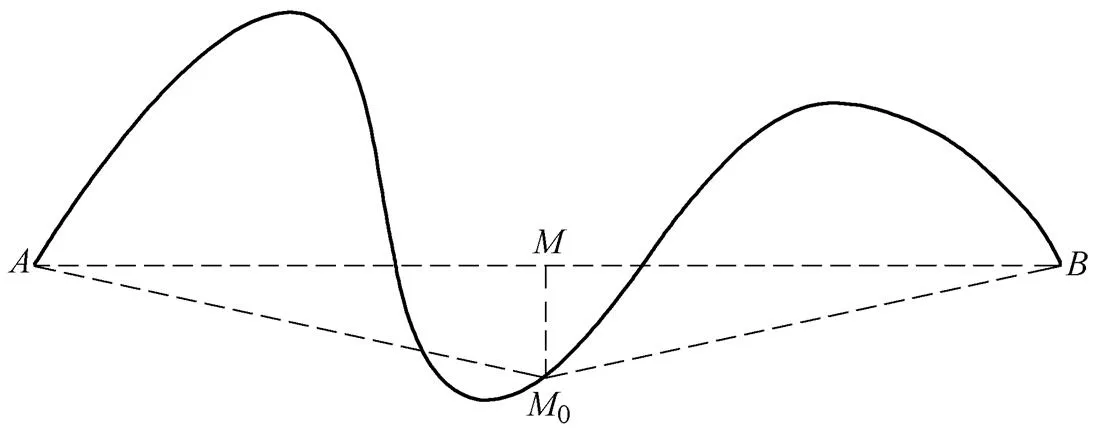
Fig. 3. Directed relative height
(3) Establishment of the curve tree layers
The directed relative height of first layer was0. We set it to the root node of the tree, then pivoted on0, repeated the operation of the directed relative height:in the same manner,, these two points were the second layer nodes. We repeated before operation based on the second layer nodes to obtain the third layer nodes.
As shown in Fig. 4 and Fig. 5, the description of the curve tree would be more accurate due to an increase in the curve tree layers. If part of the curve tends to be linear in the segmentation process, the curve rate tends to zero and the operation can be stopped.
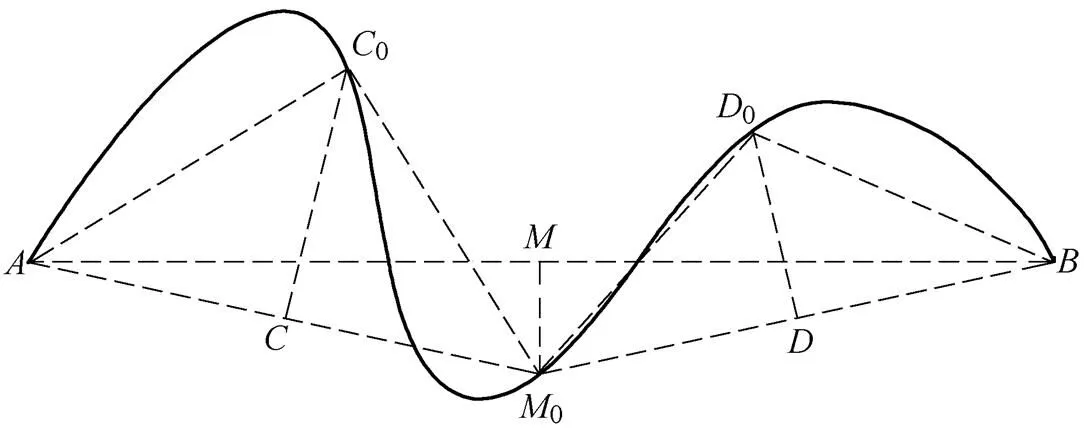
Fig. 4. Determination of the second layer nodes
By considering these curves as examples, the constructed tree was shown in Fig. 6, and the layers over three were omitted.

Fig. 5. Directed relative height
Fig. 6. Curve tree
Curve coding based on the binary tree method, which replaces the binary coding establishes an intuitive tree structure and can provide the key points for MATLAB curve fitting[46]. Consider BMW X6 as an example, as shown in Fig. 7. We extracted a contour line of the car side, as shown in Fig. 8. First, we connected the first point and the end point of the extracted curve. Second, we found the midpoint0of the straight line, constructed a vertical line through point0to intersect with curveon point0, obtained the isosceles triangle ∆0, and set its directed relative height as, of which,,we repeated thisoperation to obtain the vertical line1,2,3,4. We established the plane coordinate system in order to get the points,,0,1,2,3and4on the curve, as shown in Fig. 9.

Fig. 7. BMW X6 car side view

Fig. 8. Automobile contour line
As shown in Fig. 10, we performed the function fitting of an automobile contour form gene using the MATLAB software.

Fig. 9. Contour coding

Fig. 10. Function fitting of automobile contour form gene
5 Form Gene Clustering Method about Pan-Ethnic-Group Products Based on Emotional Semantic
The traditional PAM algorithm[47]is based on the rule of “minimum differences within the class”. The largest drawback is that the algorithm can only solve the determined target class number of the classification problem. A different form gene clustering analysis and the best clustering number analysis is required to analyse the personalised demand. It will be directly related to the number, coverage, and characteristics of the future pan-ethnic-group products.
To solve the problem of a current clustering algorithm which primarily adopts “the largest differences between classes and smallest differences within the class”, which is complex with low efficiency, this paper adopts an improved algorithm to solve the drawbacks in the PAM algorithm.
Dividesamples intoclasses, for=1,,, define

(2)
Setnto the sample size included in theth class, then
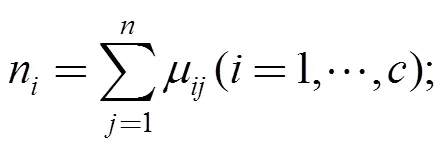
(4)
Thus the difference in theth class is

the difference in the entire class is
(6)
the difference in the entire class in a similar manner is

That is to solve the optimization problem:
(8)
The algorithm process is as follows:
Step1: Set= 3;–1, where n is the samples;
Step2: Calculateandwhen the clustering number is;
Step3: Use an optimization function to calculate the max (/), and obtain the optimal.
6 Case Study
6.1 Emotional semantic acquisition
We collected various types of pan-ethnic-group products pictures via network, magazines and other sources and treated them as the research samples. First, these pictures needed to be classified, similar samples needed to be eliminated, typical images needed to be clustered, and an investigation questionnaire needed to be constructed. We made a serial number in a certain manner and determined the semantic description words. An imagery adjective should only be related to a product form element (any adjective directly or indirectly related to the colors of the products, such as bright and colorful, would be deleted).
After factor analysis, we selected 21 pairs of emotional semantic words, as shown in Table 1.
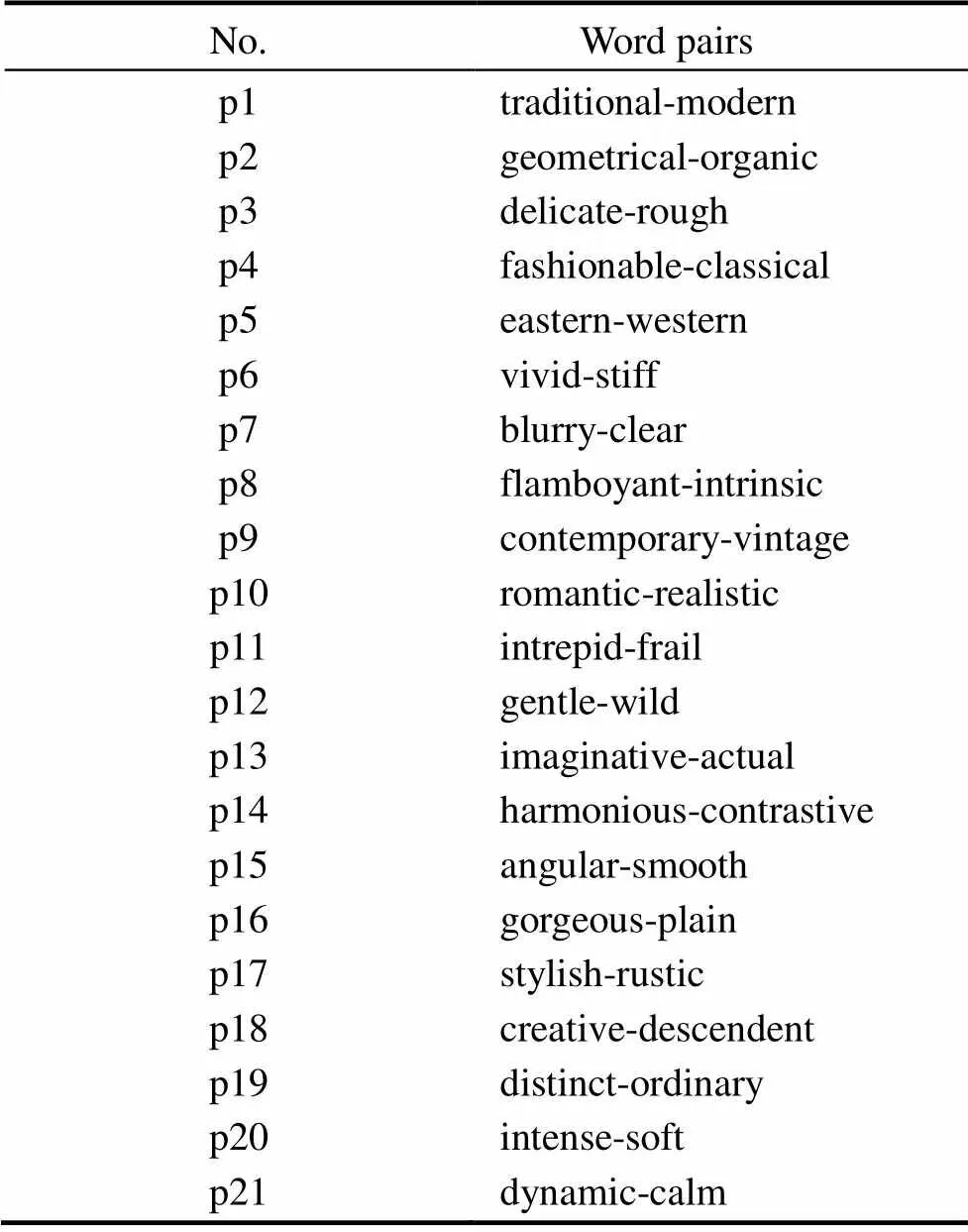
Table 1. Emotional semantic words
6.2 Form element analysis of typical pan-ethnic- group products
To reflect the marketability of the pan-ethnic-group products and the fashion trend, we selected classic or representative products from all groups. We extracted 20 typical samples from firsthand pan-ethnic-group products. To express a form gene, we normalized the size of the samples, and removed the product color and brand, as shown in Table 2.

Table 2. Form elements of typical pan-ethnic-group products
6.3 Form gene clustering of pan-ethnic-group products
We conducted questionnaire research with the above 20 form elements of pan-ethnic-group products and the selected 21 pairs of emotional semantic words, using the semantic differential method. Survey data were analyzed by the statistical software SPSS, the emotional semantic form gene pool of the pan-ethnic-group products was shown in Table 3.
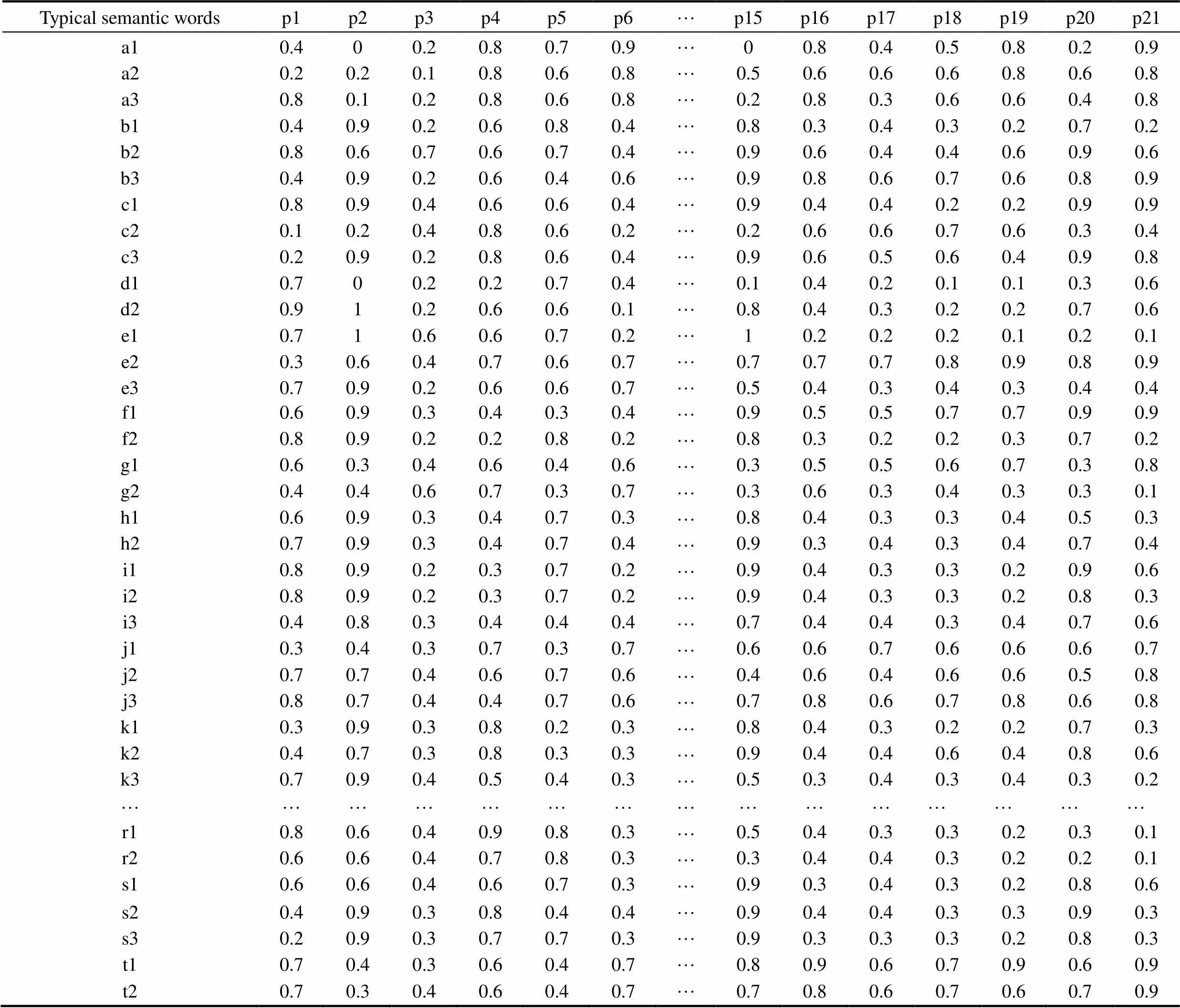
Table 3. Emotional semantic form gene pool of the pan-ethnic-group products
We used SPSS for cluster analysis[48]to obtain the optimal clustering number 4 according to Table 3, the elements in each cluster were shown in Table 4.
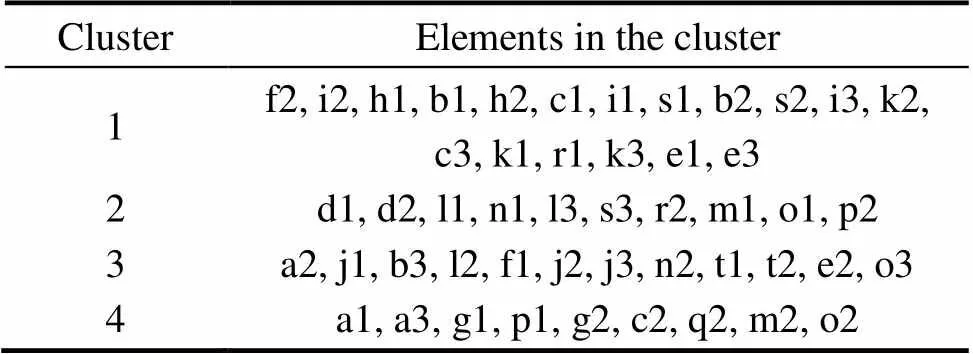
Table 4. Elements in each cluster
A graphical representation of the clustering results was shown in Fig. 11. Cluster 1 contained the vivid, romantic semantics; cluster 2 contained the geometrical, modern semantics; cluster 3 contained the traditional, gentle semantics and cluster 4 contained the distinct, creative semantics. The method combines users’ perceptual images into product form design, from which designers can obtain more inspirations with the help of the clusters.
7 Conclusions
(1) A new method to research and explore form gene clustering about pan-ethnic-group products based on emotional semantic is proposed.
(2) A clustering method is employed to improve the agility of the product design process in the era of Industry 4.0.
(3) User perceptual images of pan-ethnic-group products are considered at an early stage in product design which implements the user-centered design concept.
(4) The best clustering number is obtained by the improved algorithm.
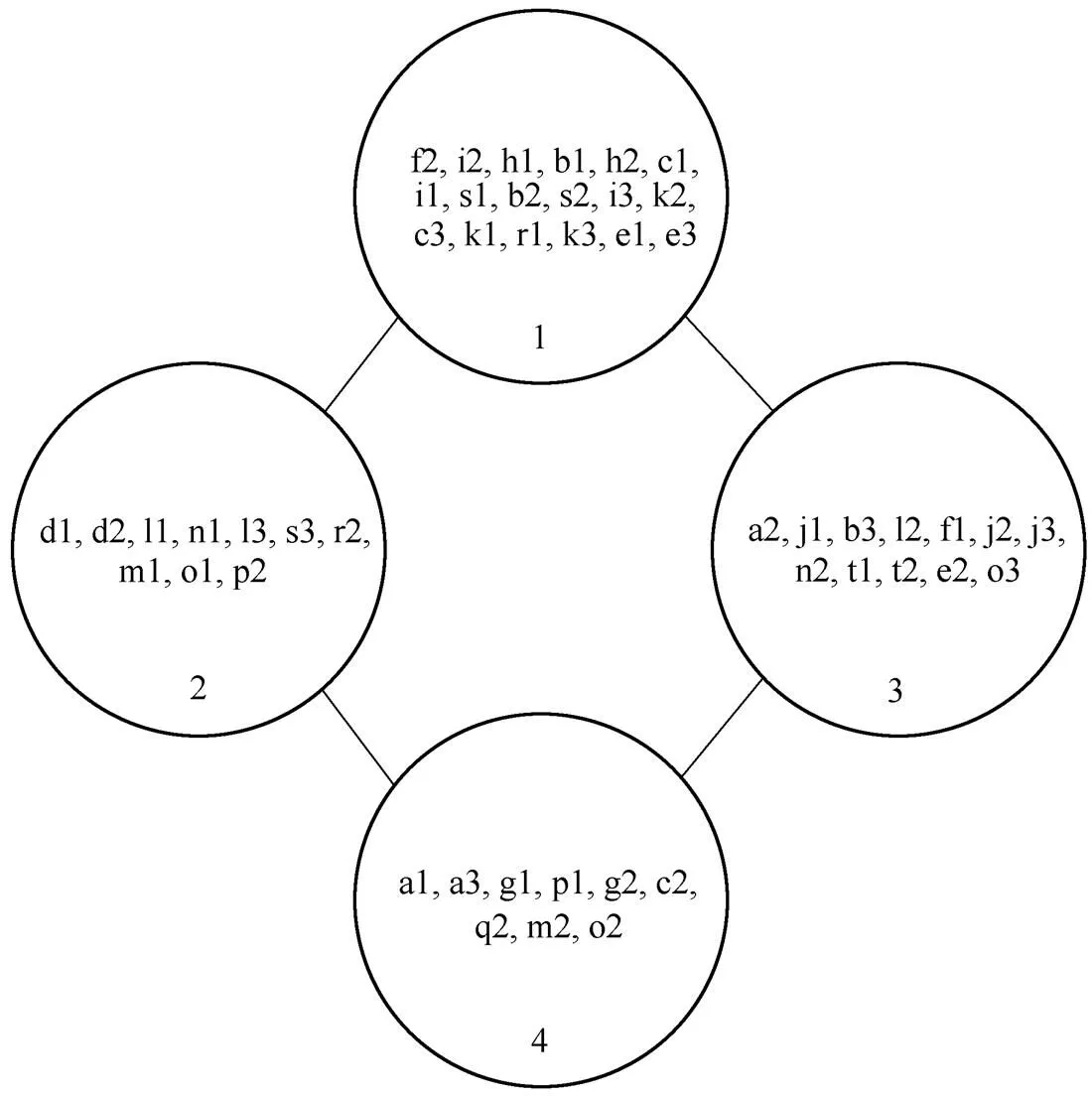
Fig. 11. Graphical representation of clustering results
[1] CHUNG M, KIM J. The internet information and technology research directions based on the fourth industrial revolution[J]., 2016, 10(3): 1311–1320.
[2] FU Yetao, LUO Shijian. Style perception-oriented product family shape gene design[J]., 2012, 18(3): 449–457. (in Chinese)
[3] MORTATI M. A framework for design innovation: present and future discussions[J]., 2015, 31(4): 4–16.
[4] LI Yutong, WANG Yuxin, DUFFY Alex H B. Computer-based creativity enhanced conceptual design model for non-routine design of mechanical systems[J]., 2014, 27(6): 1083–1098.
[5] LUO Shijian, PAN Yunhe. Review of theory, key technologies and its application of perceptual image in product design[J]., 2007, 43(3): 8–13. (in Chinese)
[6] KUANG Junsheng, JIANG Pingyu. Product platform design for a product family based on kansei engineering[J]., 2009, 20(6): 589–607.
[7] HUANG Yuexiang, CHEN Chunhsien, KHOO L P. Products classification in emotional design using a basic-emotion based semantic differential method[J]., 2012, 42(6): 569–580.
[8] LI Mingzhu, LU Zhangping, WANG Chunyan, et al. Method of product image modeling design based on shape blending[J]., 2015, 32(7): 105–108. (in Chinese)
[9] CHEN Li, ZHU Rupeng, ZHOU Haihai. Research on mining method of perceptual needs of product form in commercialization of new technology[J]., 2010, 21(23): 2803–2807.(in Chinese)
[10] YANG Jie, YANG Yu, ZHAO Chuan, et al. Customer’s kansei cognition model in product shape design[J]., 2010, 22(3): 538– 544. (in Chinese)
[11] ZHAI Lianyin, KHOO L P, ZHONG Zhaowei. A rough set based decision support approach to improving consumer affective satisfaction in product design[J]., 2009, 39(2): 295–302.
[12] PETIOT J F, YANNOU B. Measuring consumer perceptions for a better comprehension, specification and assessment of product semantics[J]., 2004, 33(6): 507–525.
[13] ZHOU Meiyu, GONG Lina, LIU Fei. Application of cluster model in kansei design[J]., 2008, 44(7): 248–252. (in Chinese)
[14] JIAO Jianxin, ZHANG Yiyang, HELANDER M. A kansei mining system for affective design[J]., 2006, 30(4): 658–673.
[15] HU Weifeng, ZHAO Jianghong. Automobile styling gene evolution driven by users’ expectation image[J]., 2011, 47(16): 176–181. (in Chinese)
[16] LUO Shijian, LI Wenjie, FU Yetao. Consumer preference-driven SUV product family profile gene design[J]., 2016, 52(2): 173–181. (in Chinese)
[17] ZHANG Yanhe, YANG Ying, LUO Shijian, et al. Mental construction of user perception image in product design[J]., 2010, 46(2): 178–184. (in Chinese)
[18] SU Jianning, ZHANG Xinxin, JING Nan, et al. Research on the entropy evaluation of product styling image under the cognitive difference[J]., 2016, 33(3): 105–108. (in Chinese)
[19] SHIEH Mengdar, YEH Yuen, HUANG Chihlung. Eliciting design knowledge from affective responses using rough sets and kansei engineering system[J].,2016, 7(1): 107–120.
[20] LLINARES C, PAGE A F. Kano’s model in kansei engineering to evaluate subjective real estate consumer preferences[J]., 2011, 41(3): 233–246.
[21] LUO Shijian, FU Yetao, KORVENMAA P. A preliminary study of perceptual matching for the evaluation of beverage bottle design[J]., 2012, 42(2): 219–232.
[22] BROWN T.[M]. New York: Harper Collins, 2009.
[23] NAGAMACHI M. Kansei engineering: a new ergonomic consumer oriented technology for product development[J]., 1995, 15(1): 3–11.
[24] NAGAMACHI M. Kansei engineering as a powerful consumer-oriented technology for product development[J]., 2002, 33( 3): 289–294.
[25] HAN Weirong, YU Suihuai, QI Bin, et al. Study of product form gene’s extraction and application based on constraint style[J]., 2012, (5): 63–67. (in Chinese)
[26] SU Jianning, WANG Ruihong, ZHAO Huijuan, et al. Optimization design of production modeling based on kansei image[J]., 2015, 22(1): 35–41. (in Chinese)
[27] FU Yetao.[D]. Zhejiang: Zhejiang University, 2012. (in Chinese)
[28] LUO Shijian, ZHU Shangshang, YING Fangtian, et al. Vision- behavior-emotion based product family design gene[J]., 2009, 15(12): 2289–2295. (in Chinese)
[29] LUO Shijian. A preliminary study of perceptual matching for the evaluation of beverage bottle design[J]., 2012, 42(2): 219–232.
[30] YANG Yanpu, YU Suihuai, CHEN Dengkai, et al. Consumer’s perceptual needs clustering based on DSM and GA[J]., 2014, 31(1): 55–58. (in Chinese)
[31] XIONG Yan, LI Yan, LI Wenqiang, et al. An image quantization of product form design method based on form feature lines[J]., 2011, 43(3): 233–238. (in Chinese)
[32] HSIAO Shihwen, LIU Mingchi. A morphing method for shape generation and image prediction in product design[J]., 2002, 23(6): 533–556.
[33] SEVA R R, HELANDER M G. The influence of cellular phone attributes on users’ affective experiences:A cultural comparison[J]., 2009, 39(6): 341– 346.
[34] PARK J, HAN S H. A fuzzy rule-based approach to modeling affective user satisfaction towards office chair design[J]., 2004, 34(1): 31–47.
[35] LAI Hsinhsi, Lin Yangcheng, YEH C H, et al. User-oriented design for the optimal combination on product design[J]., 2006, 100(2): 253–267.
[36] LAI Hsinhsi, CHANG Yuming, CHANG Huacheng. A robust design approach for enhancing the feeling quality of a product: a car profile case study[J]., 2005, 35(5): 445–460.
[37] YANG Yanpu, CHEN Dengkai, YU Suihuai, et al. Pan-ethnic- group product form design based on shape grammar[J]., 2013, 19(9): 2107–2115. (in Chinese)
[38] CHEN Hao, CUI Duwu, CUI Yingan, et al. Ethnic group evolution algorithm[J]., 2010, 21(5): 978–990. (in Chinese)
[39] HU Weifeng, XIN Xiangyang, LI Binbin. Research on the extraction and visualization of automobile brand form gene based on multi-roles expectation image[C]//, Heraklion, Crete, Greece, June 22–27, 2014: 80–88.
[40] WANG Baozhi.[D]. Hunan: Hunan University, 2009. (in Chinese)
[41] OSDOOG C E, SUCI C J, TANNENBAUM P H.[M]. Urbana: University of Illinois Press, 1957.
[42] SU Jianning, WANG Peng, ZHANG Shutao, et al. Review of key technologies of product image styling design[J]., 2013, 30(1): 97–100. (in Chinese)
[43] HE Xiaoqun.[M]. Beijing: press of Chinese people university, 2004.
[44] LI Xiaosheng, CHEN Zhenzhen. Correctly using SPSS software for principal components analysis[J]., 2010, 27(8): 105–108. (in Chinese)
[45] CHEN Xiaochun, YE Maodong, LI Chenmin. Curve description method based on binary tree[J]., 2007, 12(1): 116–120. (in Chinese)
[46] LI Qingyun, HONG Nenggu, LIU Yonghong. Research on curve fitting technology for saxophone bell profile[J]., 2008, 25(1): 212–214. (in Chinese)
[47] WU Wenliang.[D]. Guangzhou:South China University of Technology, 2011. (in Chinese)
[48] SUN Jigui, LIU Jie, ZHAO Lianyu. Clustering algorithms research[J]., 2008, 19(1): 48–61. (in Chinese)
Biographical notes
CHEN Dengkai, born in 1973, is currently an associate professor at. His research interests include industrial design, designing philosophy, ergonomics and innovative design.
E-mail: chendengkai@nwpu.edu.cn
DING Jingjing, born in 1990, is currently a master candidate at. Her research interests include computer aided industrial design and ergonomics.
E-mail: djj2014@outlook.com
GAO Minzhuo, born in 1987, is currently a master candidate at. Her research interests include data visualization information graph design.
E-mail: 1120847085@qq.com
MA Danping, born in 1991, is currently a master candidate at. Her research interests include computer aided industrial design and ergonomics.
E-mail: mdpzpl@163.com
LIU Donghui, born in 1990, is currently a master candidate at. Her research interests include computer aided industrial design and ergonomics.
E-mail: 853653995@qq.com
Received May 12, 2016; revised July 14, 2016; accepted July 19, 2016
Supported by National Key Technology R&D Program, China(Grant No. 2015BAH21F01), and National 111 Project, China(Grant No. B13044)
© Chinese Mechanical Engineering Society and Springer-Verlag Berlin Heidelberg 2016
10.3901/CJME.2016.0719.083, available online at www.springerlink.com; www.cjmenet.com
E-mail: chendengkai@nwpu.edu.cn
杂志排行
Chinese Journal of Mechanical Engineering的其它文章
- Surface Topography and Roughness of High-speed Milled AlMn1Cu
- Integrated Simulation Method for Interaction between Manufacturing Process and Machine Tool
- Engineering the Smart Factory
- Exploring Barriers and Opportunities in Adopting Crowdsourcing Based New Product Development in Manufacturing SMEs
- Development of the Supply Chain Oriented Quality Assurance System for Aerospace Manufacturing SMEs and Its Implementation Perspectives
- Collaborative Simulation Method with Spatiotemporal Synchronization Process Control
